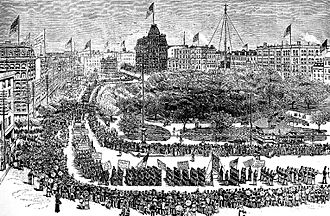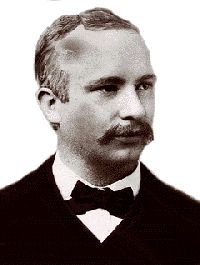Labor Day facts for kids
Quick facts for kids Labor Day |
|
|---|---|

Labor Day Parade in New York's Union Square, 1882
|
|
| Observed by | United States |
| Type | National |
| Celebrations | Parades, barbecues |
| Date | First Monday in September |
| 2024 date | September 2 |
| 2025 date | September 1 |
| 2026 date | September 7 |
| 2027 date | September 6 |
| Frequency | Annual |
| Related to | Labour Day |
Labor Day in the United States of America is a public holiday celebrated on the first Monday in September. It honors the American labor movement and the contributions that workers have made to the strength, prosperity, laws, and well-being of the country. It is the Monday of the long weekend known as Labor Day Weekend. It is recognized as a federal holiday.
Beginning in the late 19th century, as the trade union and labor movements grew, trade unionists proposed that a day be set aside to celebrate labor. "Labor Day" was promoted by the Central Labor Union and the Knights of Labor, which organized the first parade in New York City. In 1887, Oregon was the first state of the United States to make it an official public holiday. By the time it became an official federal holiday in 1894, thirty states in the United States officially celebrated Labor Day.
Canada's Labour Day is also celebrated on the first Monday of September. More than 80 countries celebrate International Workers' Day on May 1, and several countries have chosen their own dates for Labour Day. May 1 was chosen by a pan-national organization of socialist and communist political parties to commemorate the general strike and events that took place around the Haymarket affair, which occurred in Chicago on May 1 through 4, 1886.
Contents
History
Origin
Beginning in the late 19th century, as the trade union and labor movements grew, different groups of trade unionists chose a variety of days on which to celebrate labor. In the United States, a September holiday called Labor Day was first proposed in the early 1880s. Alternate stories of the event's origination exist.
According to one early history of Labor Day, the event originated in connection with a General Assembly of the Knights of Labor convened in New York City in September 1882. In connection with this clandestine Knights assembly, a public parade of various labor organizations was held on September 5 under the auspices of the Central Labor Union (CLU) of New York. Secretary of the CLU Matthew Maguire is credited for first proposing that a national Labor Day holiday subsequently be held on the first Monday of each September in the aftermath of this successful public demonstration.
An alternative thesis is maintained that the idea of Labor Day was the brainchild of Peter J. McGuire, a vice president of the American Federation of Labor, who put forward the initial proposal in the spring of 1882. According to McGuire, on May 8, 1882, he made a proposition to the fledgling Central Labor Union in New York City that a day be set aside for a "general holiday for the laboring classes". According to McGuire he further recommended that the event should begin with a street parade as a public demonstration of organized labor's solidarity and strength, with the march followed by a picnic, to which participating local unions could sell tickets as a fundraiser. According to McGuire he suggested the first Monday in September as an ideal date for such a public celebration, owing to optimum weather and the date's place on the calendar, sitting midway between the Fourth of July and Thanksgiving public holidays.
Labor Day picnics and other public gatherings frequently featured speeches by prominent labor leaders.
In 1909 the American Federation of Labor convention designated the Sunday preceding Labor Day as "Labor Sunday", to be dedicated to the spiritual and educational aspects of the labor movement. This secondary date failed to gain significant traction in popular culture.
Legal recognition
In 1887 Oregon became the first state of the United States to make Labor Day an official public holiday. By the time it became an official federal holiday in 1894, thirty U.S. states officially celebrated Labor Day. All U.S. states, the District of Columbia, and the United States territories have subsequently made Labor Day a statutory holiday.
Labor Day vs. May Day
The date of May 1 (an ancient European folk holiday known as May Day) emerged in 1886 as an alternative holiday for the celebration of labor, later becoming known as International Workers' Day. The date had its origins at the 1885 convention of the American Federation of Labor, which passed a resolution calling for adoption of the eight-hour day effective May 1, 1886. While negotiation was envisioned for achievement of the shortened work day, use of the strike to enforce this demand was recognized, with May 1 advocated as a date for coordinated strike action. The proximity of the date to the bloody Haymarket affair of May 4, 1886, further accentuated May First's radical reputation.
There was disagreement among labor unions at this time about when a holiday celebrating workers should be, with some advocating for continued emphasis of the September march-and-picnic date while others sought the designation of the more politically-charged date of May 1. Conservative Democratic President Grover Cleveland was one of those concerned that a labor holiday on May 1 would tend to become a commemoration of the Haymarket Affair and would strengthen socialist and anarchist movements that backed the May 1 commemoration around the globe. In 1887, he publicly supported the September Labor Day holiday as a less inflammatory alternative. The date was formally adopted as a United States federal holiday in 1894.
Unofficial end of summer
Labor Day is called the "unofficial end of summer" because it marks the end of the cultural summer season. Many take their two-week vacations during the two weeks ending Labor Day weekend. Many fall activities, such as school and sports begin about this time.
In the United States, many school districts resume classes around the Labor Day holiday weekend (see First day of school). Many begin the week before, making Labor Day weekend the first three-day weekend of the school calendar, while others return the Tuesday following Labor Day, allowing families one final getaway before the school year begins. Many districts across the Midwest are opting to begin school after Labor Day.
In the U.S. state of Virginia, the amusement park industry has successfully lobbied for legislation requiring most school districts in the state to have their first day of school after Labor Day, in order to give families another weekend to visit amusement parks in the state. The relevant statute has been nicknamed the "Kings Dominion law" after one such park.
In Minnesota the State Fair ends on Labor Day. Under state law public schools normally do not begin until after the holiday. Allowing time for school children to show 4-H projects at the Fair has been given as one reason for this timing.
In U.S. sports, Labor Day weekend marks the beginning of many fall sports. National Collegiate Athletic Association (NCAA) teams usually play their first games that weekend and the National Football League (NFL) traditionally play their kickoff game the Thursday following Labor Day. The Southern 500 NASCAR auto race has been held on Labor Day weekend at Darlington Raceway in Darlington, South Carolina from 1950 to 2003 and since 2015. At Indianapolis Raceway Park, the National Hot Rod Association hold their finals of the NHRA U.S. Nationals drag race that weekend. Labor Day is the middle point between weeks one and two of the U.S. Open Tennis Championships held in Flushing Meadows, New York.
In fashion, Labor Day is (or was) considered the last day when it is acceptable to wear white or seersucker.
In big cities, people try to go outside and enjoy beaches and barbecues over the Labor Day Weekend. There are also numerous events and activities organized in the cities. For example, New York offers Labor Day Carnival, fireworks over Coney Island, happy hours in restaurants, 12-hour dance parties, and many other activities. In Washington, one popular event is the Labor Day Concert at the U.S. Capitol featuring the National Symphony Orchestra with free attendance.
Labor Day sales
To take advantage of large numbers of potential customers with time to shop, Labor Day has become an important weekend for discounts and allowances by many retailers in the United States, especially for back-to-school sales. Some retailers claim it is one of the largest sale dates of the year, second only to the Christmas season's Black Friday.
| U.S. federal holidays |
|---|
| New Year's Day | Martin Luther King, Jr. Day | Presidents' Day | Memorial Day | Independence Day Labor Day | Columbus Day | Veterans Day | Thanksgiving Day | Christmas Day |
Images for kids
-
Labor Day parade on Pennsylvania Avenue in Washington, D.C. around 1894
See also
 In Spanish: Labor Day para niños
In Spanish: Labor Day para niños



